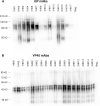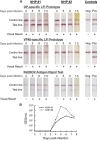Development of an antigen detection assay for early point-of-care diagnosis of Zaire ebolavirus
- PMID: 33141837
- PMCID: PMC7608863
- DOI: 10.1371/journal.pntd.0008817
Development of an antigen detection assay for early point-of-care diagnosis of Zaire ebolavirus
Abstract
The 2013-2016 Ebola virus (EBOV) outbreak in West Africa and the ongoing cases in the Democratic Republic of the Congo have spurred development of a number of medical countermeasures, including rapid Ebola diagnostic tests. The likelihood of transmission increases as the disease progresses due to increasing viral load and potential for contact with others. Early diagnosis of EBOV is essential for halting spread of the disease. Polymerase chain reaction assays are the gold standard for diagnosing Ebola virus disease (EVD), however, they rely on infrastructure and trained personnel that are not available in most resource-limited settings. Rapid diagnostic tests that are capable of detecting virus with reliable sensitivity need to be made available for use in austere environments where laboratory testing is not feasible. The goal of this study was to produce candidate lateral flow immunoassay (LFI) prototypes specific to the EBOV glycoprotein and viral matrix protein, both targets known to be present during EVD. The LFI platform utilizes antibody-based technology to capture and detect targets and is well suited to the needs of EVD diagnosis as it can be performed at the point-of-care, requires no cold chain, provides results in less than twenty minutes and is low cost. Monoclonal antibodies were isolated, characterized and evaluated in the LFI platform. Top performing LFI prototypes were selected, further optimized and confirmed for sensitivity with cultured live EBOV and clinical samples from infected non-human primates. Comparison with a commercially available EBOV rapid diagnostic test that received emergency use approval demonstrates that the glycoprotein-specific LFI developed as a part of this study has improved sensitivity. The outcome of this work presents a diagnostic prototype with the potential to enable earlier diagnosis of EVD in clinical settings and provide healthcare workers with a vital tool for reducing the spread of disease during an outbreak.
Conflict of interest statement
I have read the journal's policy and the authors of this manuscript have the following competing interests: InBios International Inc. (Seattle WA) was awarded the contract with a subcontract issued to the AuCoin laboratory at the University of Nevada, Reno. The authors have declared that no competing interests exist.
Figures



Similar articles
-
Lateral Flow Immunoassays for Ebola Virus Disease Detection in Liberia.J Infect Dis. 2016 Oct 15;214(suppl 3):S222-S228. doi: 10.1093/infdis/jiw251. Epub 2016 Jul 20. J Infect Dis. 2016. PMID: 27443616 Free PMC article.
-
Comparative performance of four rapid Ebola antigen-detection lateral flow immunoassays during the 2014-2016 Ebola epidemic in West Africa.PLoS One. 2019 Mar 7;14(3):e0212113. doi: 10.1371/journal.pone.0212113. eCollection 2019. PLoS One. 2019. PMID: 30845203 Free PMC article.
-
Analytical Validation of the ReEBOV Antigen Rapid Test for Point-of-Care Diagnosis of Ebola Virus Infection.J Infect Dis. 2016 Oct 15;214(suppl 3):S210-S217. doi: 10.1093/infdis/jiw293. Epub 2016 Aug 31. J Infect Dis. 2016. PMID: 27587634 Free PMC article.
-
Towards detection and diagnosis of Ebola virus disease at point-of-care.Biosens Bioelectron. 2016 Jan 15;75:254-72. doi: 10.1016/j.bios.2015.08.040. Epub 2015 Aug 20. Biosens Bioelectron. 2016. PMID: 26319169 Free PMC article. Review.
-
Ebola virus disease.Nat Rev Dis Primers. 2020 Feb 20;6(1):13. doi: 10.1038/s41572-020-0147-3. Nat Rev Dis Primers. 2020. PMID: 32080199 Free PMC article. Review.
Cited by
-
Recent Advances in Therapeutic Approaches Against Ebola Virus Infection.Recent Adv Antiinfect Drug Discov. 2024;19(4):276-299. doi: 10.2174/0127724344267452231206061944. Recent Adv Antiinfect Drug Discov. 2024. PMID: 38279760 Review.
-
Lateral flow assays (LFA) as an alternative medical diagnosis method for detection of virus species: The intertwine of nanotechnology with sensing strategies.Trends Analyt Chem. 2021 Dec;145:116460. doi: 10.1016/j.trac.2021.116460. Epub 2021 Oct 21. Trends Analyt Chem. 2021. PMID: 34697511 Free PMC article. Review.
-
Ten Years of Lateral Flow Immunoassay Technique Applications: Trends, Challenges and Future Perspectives.Sensors (Basel). 2021 Jul 30;21(15):5185. doi: 10.3390/s21155185. Sensors (Basel). 2021. PMID: 34372422 Free PMC article. Review.
-
Rapid diagnostic tests versus RT-PCR for Ebola virus infections: a systematic review and meta-analysis.Bull World Health Organ. 2022 Jul 1;100(7):447-458. doi: 10.2471/BLT.21.287496. Epub 2022 Jun 1. Bull World Health Organ. 2022. PMID: 35813519 Free PMC article.
-
Development of a dual antigen lateral flow immunoassay for detecting Yersinia pestis.PLoS Negl Trop Dis. 2022 Mar 23;16(3):e0010287. doi: 10.1371/journal.pntd.0010287. eCollection 2022 Mar. PLoS Negl Trop Dis. 2022. PMID: 35320275 Free PMC article.
References
-
- Organization WH. Ebola virus disease–Democratic Republic of the Congo, Disease outbreak news: Update 21 March 2019. World Health Organization, 2019. 2019-02-14 18:53:09. Report No.
Publication types
MeSH terms
Substances
Grants and funding
LinkOut - more resources
Full Text Sources
Medical

